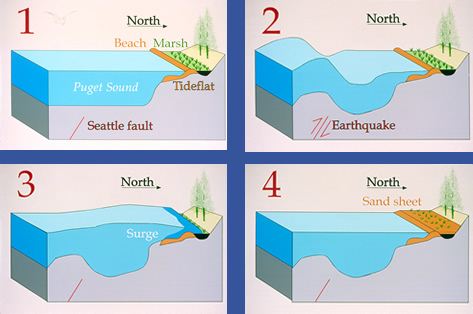Earthquake Research
Thanks to the support of universities and public
agencies, geologists have been able to investigate the mechanisms
of earthquakes and learn about their damaging effects.
A Great Detective Story
Like detectives arriving on the scene long after a crime has been
committed, geologists look for clues in the landscape in order to
understand the past. By the 1980s, geologists were wondering whether
there had ever been devastating earthquakesBig Onesin
the Pacific Northwest. Brian Atwater was one of those geologists.
As his research began to uncover clues to the Big One mystery, his
discoveries have transformed our understanding of Northwest geology
and the risks we face.
Clue One: Ghost
forests
Ghost forestslong-dead treesstand stark along
the coasts of Washington and Oregon. Atwater knew that similar
stands of trees in Alaska had been killed after the Prince William
Sound earthquake of 1964. He realized that the Alaskan quake
had caused parts of the forest to drop below sea level. Tidewater
had rushed in, drowning the trees. Over time, tidal mud accumulated
and the area became a salt marsh and then a coastal meadow.
But the dead trees still stood. |
 |
 |
Tree drowning
1. Living coastal forest
2. Land level drops, tidewater drowns tree roots
3. Tidal mud accumulates and salt marsh develops |
Clue Two: Tsunamis
Atwater wondered whether the Washington and Oregon ghost forests
were like Alaskas drowned forests. He knew that great subduction
zone earthquakes usually produce tsunamismassive waves that
travel with jet-like speed across the ocean. Near shore, tsunamis
reach towering heights and surge far inland. When Atwater looked
at the ghost forests, he found distinctive layers of sand over the
soil. This was another clue to the mystery.
 |
Earthquakes cause tsunamis
- The coast before an earthquake
- Land level changes during an earthquake, tsunami waves
generated
- Tsunami surges onto shore
- Sand deposited over the land
|

Land layers in an Oregon ghost forest
(from top)
Marsh plants today
Tidal mud (gray layer)
Sand deposited by tsunami in year 1700 (light layer)
Old topsoil (very dark layer)
Fire pits with charcoal, used by Native Americans (swellings in
the very dark layer)
Next Page
|

